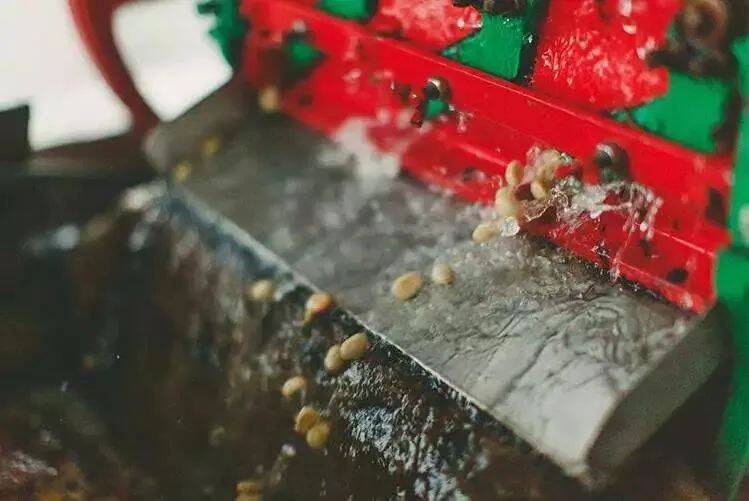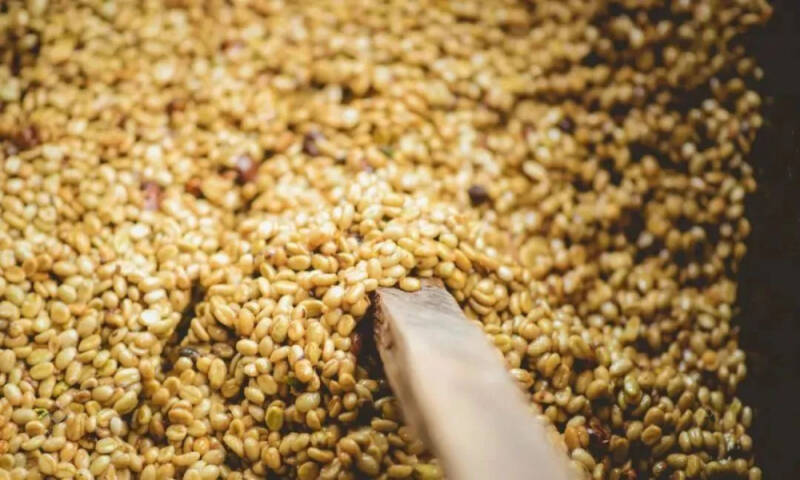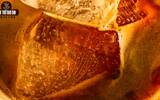How does coffee break out of rich layers? Which is better, washed coffee beans or sun-dried coffee beans?
Not long ago, Qianjie Store welcomed an iron powder who washed beans. He once bought a lot of washed coffee, but he couldn't get a sense of hierarchy at home, so he asked Qianjie if he had any skills or suggestions. So today let's discuss the brewing plan for washed coffee.
What is washed coffee?
The "water washing process" in coffee is translated from the English "Washed process" and is also called "Wet process" in the origin of production, which means "wet process."
From the outside to the inside, a coffee cherry is the peel, pulp, pectin, parchment, and coffee beans. The coffee we drink every day is the innermost seed. Conventional "washing" has a relatively simple process sequence: removing flaws → peeling by the machine → fermentation in the pool → washing → drying → shelling → packaging. As for other washing treatments, they are adjusted based on traditional operations. For example, double washing in Kenya uses multiple immersion washing methods to further remove residual pectin.

As a traditional method of processing raw beans, the water washing method was born to improve the quality of coffee and make the production of each batch of raw beans stable and efficient to achieve profit. Therefore, to this day, water washing is still the most common and popular treatment methods in the origin. One of the most common and popular treatments, we can find its shadow in the information columns of many coffee beans, such as Qianjie fruit ding, Qianjie small tomatoes, Qianjie emerald green label, Qianjie Kilimanjaro... all have credit for the water washing method.
What are the characteristics of washed coffee?
Since the raw beans are kept bare and soaked in water for fermentation during the washing process, and the pectin component is completely removed by washing, compared with the sun, they can highlight the characteristics of the coffee seeds themselves and almost no There is too much fermentation feeling, so the cleanliness is higher.

In order to more clearly present the tonality of the coffee production area (or variety), roasters will use the appropriate degree of baking for different washed beans, such as the bright citrus acid of washed fruit tintin, the tomato juice feeling of washed Kenya, and the white floral fragrance of washed Panama rose summer and its clean and quiet tonality... are all places that people are fascinated by washed coffee. At the same time, many new friends will fall into the misunderstanding that "washed coffee must be more sour than sun-cured coffee."
Qianjie needs to be corrected. The acid in these coffees is mainly determined by the degree of roasting and has little to do with the processing method. Here is an example. Qianjie bakes the golden Mantelin, which has a mellow taste, until it is baked. It can also show high-intensity acidity. As for whether it tastes good or not, it is a matter of opinion.
The reason why we think that "washed beans are more sour" is also because sun-dried coffee is dried with the peel and pulp, which easily releases complex aroma of fermentation into the seeds, allowing us to feel tropical fruits, light aroma, candied fruits, brown sugar and other mellow flavors. Qianjie once compared water-washed Panamanian rose summers and sun-washed Colombia rose summers using the same set of parameters. It was found that sun-washed rose summers smell sweeter than washed summers, but the acidity at the entrance was much higher than that of washed summers.
What brewing plan is suitable for washed coffee beans?
It was also said in a paragraph on Qianjie that the reason why many washed beans are "deep" is mainly because of their unique clean and quiet flavor and the bright flowers and fruits under medium and light baking. Therefore, if you want to make coffee drink, it is well-structured and the brewing concentration should not be too high. Qianjie will choose 1:16 for extraction.
In addition, under the same parameters, the shallower the roasting degree, the lower the solubility of the coffee powder in water. At this time, if you want to improve the extraction rate of coffee, in addition to the fine grinding and high water temperature often mentioned in Qianjie, you can actually increase the number of segments + Increase the form of water flow to further grasp.
Although they are all washed, Qianjie believes that coffee with fruit acid can be roughly divided into two categories: one is the thick acid of dark berry-like classics represented by Kenya and Rwanda, and the other is the fresh charm of white citrus, which is mostly found in washed coffee beans in Ethiopia, Panama, Peru, and Colombia.
Here, Qianjie Tomato, a double-washed coffee from Kenya, is used. In order to highlight its full and juicy taste and rich layers, Qianjie will be used with V60 for extraction. The design of the spiral convex groove allows the water flow to produce the powder layer. More adequate "extrusion" meets the water absorption and expansion of the coffee particles to the greatest extent.
Coffee beans: Front Street Kenya·Little Tomatoes
Powder amount: 15 grams
Powder to water ratio: 1:16
Total water injection volume: 240g (40g+70g+70g+60g)
Degree of grinding: EK43 10 scale (pass rate of No. 20 sieve is 80%/25 grids of C40 bean grinder)
Water temperature: 93℃
Filter cup: Hario V60 #01
Water injection technique: four-stage style
First, pour 15g of coffee powder into V60 and gently pat it flat. In the first section, inject 40g of water into a small water stream from inside to outside and steam for 30 seconds. Be careful to moisten all coffee powder to facilitate venting.
After 30 seconds, inject the second section and inject 70g of hot water in a vertical circle. The water flow can be slightly raised and the powder bed can be quickly lifted to half of the filter cup, which can allow the flavor to be better displayed;
When the coffee liquid falls and is about to expose the powder bed, the time is 1 minute and 09 seconds. Start injecting the third section. The method is consistent with the amount of water in the previous section. When 70g of hot water is injected, the liquid level will be just flush with the previous section. Compared with steaming, these two sections of hot water are mainly responsible for releasing the fruit acid part and caramelized aroma of the washed beans. Therefore, careful not to pour the water on the filter paper, which may easily cause insufficient extraction.
When the liquid level drops to halfway, the time is about 1 minute and 41 seconds, and the last 60g is injected. It is mainly responsible for extracting the sweetness and mellow taste of the washed coffee, so there is no need for too much water flow and keeping the center point flushed.
The young tomatoes that are washed out in this way are exactly what their name is. They have a dense tomato aroma. The entrance is rich berry acid from blueberries and black grapes, as well as a hint of caramel. As the temperature drops, the soft light floral and Sydney flavor begin to change. Obviously, the juice feel is solid, and it is very rich in both layers and charm.
- END -
Important Notice :
前街咖啡 FrontStreet Coffee has moved to new addredd:
FrontStreet Coffee Address: 315,Donghua East Road,GuangZhou
Tel:020 38364473
- Prev

What are the five ways to drink American coffee? What is the difference between American coffee and Long Black? How to make quicksand ice American style? How to pull flowers in American coffee? Can I take milk in American coffee?
Everyone! So! Chow! Know! In Italian coffee, the combination of milk and coffee had an extremely rich drinking method. Just by changing the method or parameters slightly, there were countless methods for milk and coffee alone. The familiar ones include latte, cappuccino, Australian white, piccolo, cotado, macchiato and so on. and rebelled
- Next

How to do proportional steps for 400 times of foamed coffee? What is the reason why espresso cannot foam?
Whenever I open a social networking site, the homepage will push a tutorial on making foam coffee to Qianjie every once in a while. After searching, I find a full picture. As more and more people try it at home, failure cases are beginning to appear frequently. Many netizens say that the foam coffee they make is simply "completely different" from the original version, and it is not
Related
- Being chased out of the rain in front of Starbucks?! Store: Sheltering from rain under umbrellas poses a safety hazard
- The white moonlight has changed?! Lucky launches "Big Winter Pear American"
- Hand-brewed coffee three-stage method, high-sweet and universal brewing method to share! What does the high sweet water level of hand-brewed coffee mean?
- What is the difference between raw, refined and full espresso coffee? How to extract espresso and taste good?
- A complete list of coffee bean names and their meanings! What is Yejia Shefi coffee? Where is Mantelin coffee?
- What grade does Arida Manor Kaduai coffee beans belong to? What treatment is Arida ASD slow anaerobic sun exposure?
- The milk tea cup becomes smaller?! Overlord Tea Girl launches a new "Return to Yunnan" series
- Accused of selling counterfeit and high-priced coffee beans! Well-known boutique coffee brand "Oukelao" bowed and apologized!
- How to make espresso dumplings? Can I eat coffee and glutinous rice balls together?
- Save the unformed and stagnant powder cakes in one second! What is the problem with stagnant water in the powder bowl of the espresso machine?

